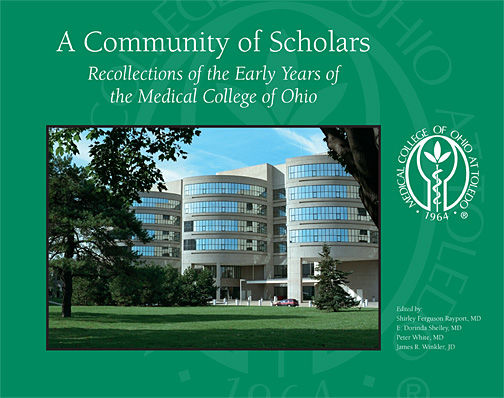 Few remember the day in 1980 when hospital administrators called for 20 umbrellas to the ground floor of the Clement O. Miniger Radiation Oncology Center because of flooding, or know that Nobel Laureate Dr. Charles Huggins dubbed Toledo “the Cornish hen capital of the world.” Read about these stories and learn more in A Community of Scholars, Recollections of the Early Years of the Medical College of Ohio.
Few remember the day in 1980 when hospital administrators called for 20 umbrellas to the ground floor of the Clement O. Miniger Radiation Oncology Center because of flooding, or know that Nobel Laureate Dr. Charles Huggins dubbed Toledo “the Cornish hen capital of the world.” Read about these stories and learn more in A Community of Scholars, Recollections of the Early Years of the Medical College of Ohio.
The book was the idea of Dr. Mark Rayport, professor emeritus of neurological surgery and radiology and founding chair of the Department of Neurological Surgery at the Medical College of Ohio, and Dr. J. Thomas Martin, professor emeritus of anesthesiology and former chair of the Department of Anesthesiology. They took the idea to the Health Sciences faculty retirees group, MCO Faculty Seniors, which then undertook the task of making the concept a reality.
The Faculty Seniors raised and contributed funds to finance the book, and with the additional support given by Lawrence J. Burns, vice president for external affairs and interim vice president for equity and diversity, Dr. Jeffrey P. Gold, chancellor, executive vice president for biosciences and health affairs, and dean of the College of Medicine and Life Sciences, and UT President Lloyd Jacobs, the story of the early years of the Medical College of Ohio came together in this 372-page volume.
The goal of this undertaking was to cover the first 25 years of the Medical College of Ohio. The college was established in 1964 and the first class of medical students began in 1969. When the first class convened, MCO was the fourth medical school in Ohio and the 100th in the nation. A Community of Scholars begins with this first class, covering up to about 1995.
The four editors, Dr. Shirley Ferguson Rayport, Dr. E. Dorinda Shelley, Dr. Peter White and James R. Winkler, part of the MCO Faculty Seniors, recruited the nearly 70 authors who contributed personal recollections and accounts in an attempt to recreate the spirit of those early years.
As Peter White, editor and longtime member of the medical school faculty in the Hematology/Oncology Division of the Department of Medicine, writes in his introduction, “This book is not intended to be comprehensive but is rather an attempt to tell what faculty members of the time remember of the triumphs and challenges of the early years of the medical college.”
It includes chapters for each academic department in the school of medicine, a chapter for the school of nursing, a chapter written by former students and a chapter about the administration. It also features hundreds of photographs of students, nurses, faculty and physicians.
“Not just another dusty history book, this is a chronicle of the development of a new medical school with lessons that apply to anyone who is developing new education programs, particularly in medicine,” White said.
A Community of Scholars offers a glimpse into the humanity of physicians and professors of medicine, a side that often goes unseen. It tells the story of Toledo’s fight against competing medical schools in Ohio, the rally of a community with a vision, and the “political spadework” that had to be done for this vision to become the respected institution that it is today. It is a book about history, a book about humanity, and a book about the courage and tenacity of a community united.
A Community of Scholars: Recollections of the Early Years of the Medical College of Ohio is available for purchase for $30 through The University of Toledo Press at www.utoledopress.com.